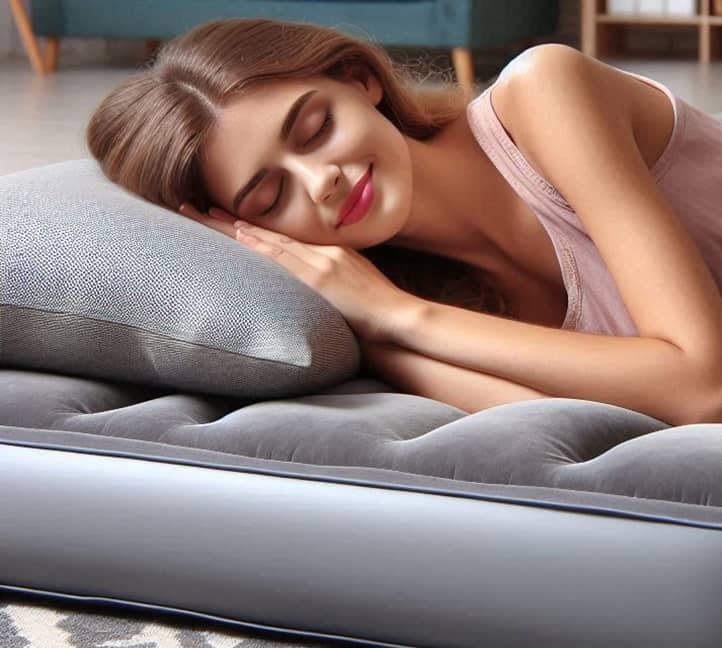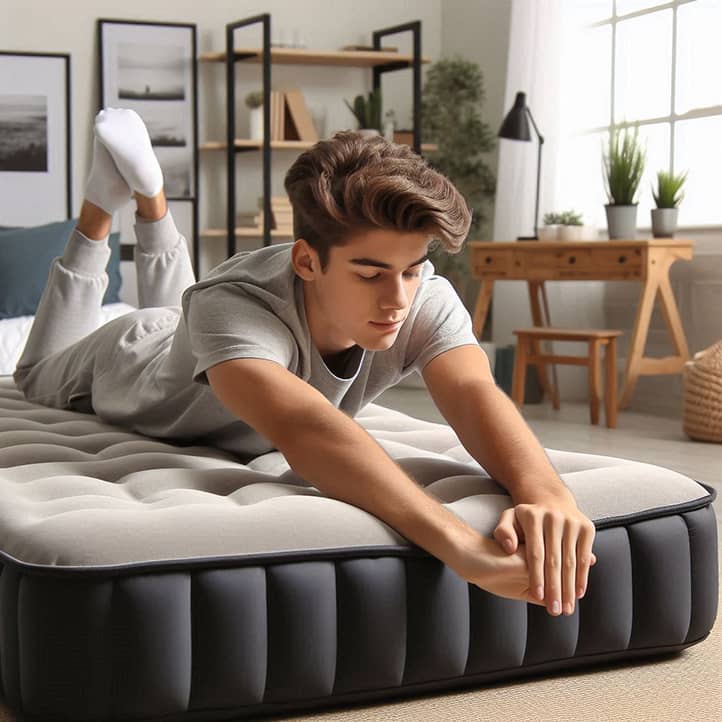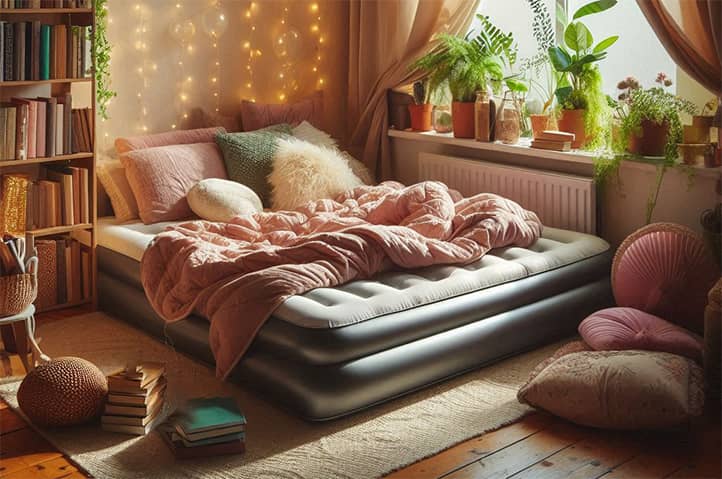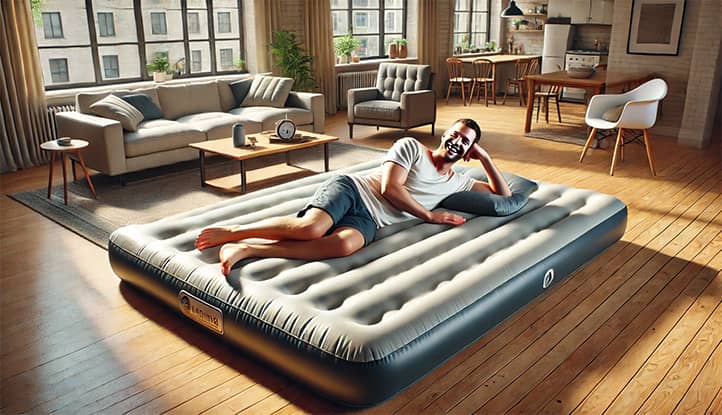Sleep is an integral part of our lives, playing a key role in restoring physical and mental energy. But what makes some sleeping surfaces more comfortable and relaxing than others? In recent years, more and more people have been noticing the calming effect of inflatable mattresses. This phenomenon is attracting interest not only from regular users but also from sleep psychology specialists.

Physical Properties of Inflatable Mattresses
In the world of sleep and relaxation, inflatable mattresses hold a unique position, offering a distinctive blend of physical characteristics. These lightweight and compact products, filled with air, create a special environment for the body, balancing support with softness. Their ability to mold to the body’s shape feels like an embrace from a cloud, gently enveloping every curve.
The air inside the mattress acts as a dynamic cushion, responding to even the slightest movements of the sleeper. This creates a micro-massage effect, subtly stimulating circulation and promoting muscle relaxation. Each movement on an inflatable mattress generates a gentle wave that ripples across the surface, giving a sensation of rocking on calm water.
The texture of inflatable mattress surfaces is also noteworthy. Unlike traditional mattresses, they have a unique smoothness and elasticity, which minimizes friction and allows the body to move freely during sleep. This aspect is especially important for people with sensitive skin or a tendency to develop pressure sores when staying in one position for extended periods.
Softness and Flexibility of the Surface
One of the key characteristics of inflatable mattresses is their unique softness and flexibility. Unlike traditional mattresses with fixed firmness, inflatable models allow the level of air filling to be adjusted, thereby customizing the support level to individual preferences.
This adaptability of the surface has several advantages:
- Even weight distribution. The soft surface of an inflatable mattress allows the body to “sink” into it, supporting all curves and contours. This reduces pressure on specific body points, which is especially beneficial for people with joint issues or sensitive skin.
- Reduced muscle tension. Thanks to its ability to conform to the body’s shape, an inflatable mattress naturally helps muscles relax. This is particularly noticeable in the back and neck areas, where tension often builds up during the day.
- Comfort for various sleep positions. Whether you sleep on your back, side, or stomach, the flexibility of the inflatable mattress provides comfortable support in any position.
Gentle Rocking with Movement
Another unique feature of inflatable mattresses is the gentle rocking that occurs with movement. This effect is due to the air inside the mattress, which shifts in response to changes in body position.
The impact of this rocking on sleep quality is multifaceted:
- Cradle-like effect. The gentle movements of the mattress can evoke sensations similar to being rocked in a cradle. This activates deep relaxation mechanisms that are embedded since infancy.
- Vestibular stimulation. Soft oscillations stimulate the vestibular system, which may promote faster sleep onset and deeper rest.
- Distraction from anxious thoughts. Focusing on the mattress’s gentle movements helps distract from intrusive, anxious thoughts that often interfere with sleep.
The Sound of Air Inside the Mattress
While it might seem like a minor factor, the sound of air moving inside the inflatable mattress during motion also contributes to creating a calming atmosphere.
The Influence of Sound on Falling Asleep:
- White noise. The quiet rustling of air within the mattress resembles the effect of white noise, which is known to promote relaxation and improve sleep quality.
- Masking external noises. The faint sound of the mattress can help mask other, more irritating sounds in the environment, creating a calmer sleeping atmosphere.
- Rhythmicity. During regular movements in sleep, the sound of air inside the mattress can create a soothing rhythmic pattern that supports deep sleep.
Thus, the physical properties of inflatable mattresses—their softness, gentle rocking ability, and unique sound characteristics—create comprehensive conditions that contribute to deep relaxation and quality sleep.

Psychological Aspects
The human brain is a remarkable instrument of associations and memories. Inflatable mattresses are often associated with pleasant moments in life: vacations, travel, and nature outings. This connection activates a cascade of positive emotions in our consciousness, which in themselves promote relaxation and stress relief. As we sink into the softness of an inflatable mattress, we immerse ourselves in pleasant memories.
Interestingly, an inflatable mattress can serve as a kind of “anchor” for mindfulness practice. Its unique tactile sensations, gentle rocking, and even the specific smell of the material can become a focal point for meditative practices. Concentrating on these sensations helps to distract from anxious thoughts and daily hustle, promoting deeper relaxation.
The psychological aspect of the “temporariness” of an inflatable mattress also plays a role. Unlike a permanent bed, an inflatable mattress is perceived as something temporary, which paradoxically may contribute to deeper relaxation. This is because we are less likely to project everyday stresses and worries onto it, perceiving the time spent on it as a sort of “break” from everyday life.
Associations with Rest and Relaxation
Inflatable mattresses are often associated with vacation, travel, and outdoor relaxation. This psychological connection plays a significant role in their calming effect:
- Positive memories. Many people use inflatable mattresses while on vacation or outdoor trips. These pleasant memories can automatically evoke a sense of relaxation and tranquility when using such a mattress at home.
- Expectation of rest. Simply being on an inflatable mattress can create a mental setting for rest and relaxation, helping to “disconnect” from daily concerns and stress.
- Novelty effect. For many people, sleeping on an inflatable mattress is a departure from daily routine, which in itself can be a pleasant change that promotes better rest.
Feeling of Safety and “Cocooning”
Inflatable mattresses have a unique ability to create a feeling of safety, which is psychologically important for quality sleep:
- “Nest” effect. The soft edges of an inflatable mattress can gently rise around the body, creating a sense of being in a protected space, like a nest.
- Isolation from the outside world. The slight elevation above the floor and soft edges of the mattress can create a feeling of separation from the surrounding space, which promotes psychological relaxation.
- Tactile comfort. The softness and warmth of the inflatable mattress surface can evoke sensations similar to a hug or being cocooned, which subconsciously associates with safety and comfort.
Novelty of Sensations as a Stress-Relief Factor
The unfamiliar sensations associated with using an inflatable mattress play a positive role in reducing stress and improving sleep quality:
- Switching focus. Unusual tactile and kinesthetic sensations distract the brain from anxious thoughts and daily worries.
- Relaxation stimulation. New sensations can activate the brain’s reward system, generating a feeling of pleasure and promoting relaxation.
- Mindfulness effect. Focusing on the unique sensations from the inflatable mattress acts as a form of mindfulness practice, helping to stay in the present moment and not worry about the future.

Impact on Sleep Quality
Sleep is not simply a period of inactivity but a complex physiological process that is critically important for our health and well-being. Inflatable mattresses make a unique contribution to this process, influencing various aspects of sleep quality. Their ability to adapt to body shape helps achieve the optimal sleeping position, which is especially beneficial for people with musculoskeletal issues.
The slight instability of the inflatable mattress surface can stimulate the vestibular system, which, according to some theories, promotes faster sleep onset and deeper rest. This resembles the rocking effect many experienced in childhood, which remains an effective aid to better sleep even in adulthood.
Moreover, the ability to adjust the firmness of the inflatable mattress by changing the air level allows each user to find their ideal balance of support and softness. This personalized approach to sleep comfort can significantly enhance rest quality, allowing the body to relax and recover fully.
Reducing Muscle Tension
One of the key factors affecting sleep quality is the degree of muscle tension. Inflatable mattresses possess unique properties that help reduce this tension:
- Even pressure distribution. Due to its flexibility, an inflatable mattress distributes body weight more evenly than many traditional mattresses. This helps avoid excessive pressure on specific body areas, which can cause discomfort and muscle tension.
- Adaptation to body contours. The ability of an inflatable mattress to conform to the natural curves of the body allows muscles to relax in their most comfortable position. This is especially important for people with back or joint problems.
- Micro-movements. The slight instability of the inflatable mattress surface can stimulate small, almost imperceptible body movements during sleep. These micro-movements help prevent muscle stiffness and promote relaxation.
Improving Blood Circulation
Proper blood circulation during sleep is critically important for quality rest and body recovery. Inflatable mattresses positively affect circulation in the following ways:
- Reduction of pressure points. The even distribution of body weight on an inflatable mattress helps avoid pinching blood vessels, which can occur on firmer surfaces.
- Supporting natural body alignment. The mattress’s ability to conform to the body’s shape helps keep the spine and limbs in optimal positions, facilitating uninterrupted blood flow.
- Encouraging small movements. The slight instability of the surface can stimulate small movements during sleep that help “pump” blood, especially in the extremities.
Possible Effects on Sleep Stages
Sleep quality largely depends on the proper alternation of its stages. While direct studies on the effects of inflatable mattresses on sleep stages are still lacking, the following effects can be assumed:
- Easier sleep onset. The comfortable conditions and psychological relaxation provided by the inflatable mattress may facilitate faster sleep initiation.
- Sustaining deep sleep. Even pressure distribution and reduced muscle tension may help maintain longer periods in the deep sleep phase, which is critical for body recovery.
- Fewer sleep interruptions. Comfortable conditions may reduce the number of micro-awakenings during the night, often caused by uncomfortable body positions or localized discomfort.
- Potential impact on REM sleep. Gentle movements of the mattress have a stimulating effect on the vestibular system, which theoretically can influence the intensity and duration of the rapid eye movement (REM) sleep phase.
It is important to note that individual responses to air mattresses may vary, and what works best for one person may not work for another. In addition, further scientific research using polysomnography and other objective methods of assessing sleep quality is needed to obtain accurate data on the effects of air mattresses on sleep patterns.

Comparison with Other Sleeping Surfaces
The world of sleeping surfaces is diverse, with each type offering unique characteristics. In this spectrum, air mattresses hold a special place by combining elements from various types of beds. They blend the adaptability of waterbeds, the lightness of hammocks, and the practicality of traditional mattresses, creating a unique sleep experience.
Interestingly, air mattresses can act as a kind of “bridge” between different types of sleeping surfaces. For those accustomed to a firm surface but looking to try something softer, an air mattress can be the ideal intermediate choice. Its adjustable firmness allows for gradual adaptation to new sensations.
Additionally, air mattresses possess a unique ability to “reset” the sleep experience. Unlike a permanent bed that the body becomes accustomed to over the years, an air mattress offers a new experience each time. This can be especially helpful for people suffering from chronic pain or discomfort during sleep, as it allows them to “reboot” habitual sleep patterns and find a new, more comfortable position.
Traditional Mattresses
Traditional mattresses remain the most common choice for sleep, but they have several distinctions compared to air mattresses:
- Surface stability. Traditional mattresses provide a more stable sleeping surface, which may be preferable for people who dislike even minimal movements during their rest.
- Variety of materials. Traditional mattresses are made from a variety of materials (springs, memory foam, latex), allowing individuals to select an option tailored to their specific needs.
- Durability. Quality traditional mattresses generally last longer than air mattresses and retain their properties over time.
- Temperature regulation. Many modern mattresses feature technology to optimize body temperature regulation during sleep, which may be less pronounced in inflatable models.
However, air mattresses have their own advantages:
- Adjustable firmness. The ability to vary air pressure allows customization of firmness to suit individual preferences.
- Portability. Air mattresses are easy to transport and store, making them ideal for travel or temporary use.
- Weightless effect. Some people report a sensation of “floating” on an air mattress, which can enhance relaxation.
Waterbeds
Waterbeds, while less popular today, share certain characteristics with air mattresses:
- Adaptability to body shape. Like air mattresses, waterbeds conform well to body contours, distributing weight evenly.
- Movement. Waterbeds also provide gentle movement, which some find soothing.
- Temperature adjustment. Unlike air mattresses, many waterbeds allow for water temperature adjustment, which can improve sleep quality.
However, waterbeds have certain disadvantages:
- Weight and setup complexity. They are much heavier and more challenging to set up than air mattresses.
- Risk of leaks. There is a risk of damage and leakage, potentially leading to serious issues.
- Cost. Waterbeds are usually more expensive to purchase and maintain.
Hammocks
Hammocks represent another intriguing sleeping option, especially popular in certain cultures and among nature enthusiasts:
- Rocking effect. Hammocks offer more pronounced swaying, which many find calming.
- Reduced pressure on the body. In a hammock, the body is slightly curved, reducing pressure on the spine.
- Connection to nature. Using a hammock, especially outdoors, enhances a sense of unity with nature.
However, hammocks have their limitations:
- Limited sleeping positions. Hammocks usually support only one sleeping position, which may be uncomfortable for some.
- Difficulty in use. Getting in and out of a hammock can be challenging, especially for people with limited mobility.
- Temperature control. Temperature regulation can be difficult in a hammock, especially in colder weather.
In comparison to these alternatives, air mattresses represent a sort of “golden middle,” combining some of the benefits of each option: adaptability of waterbeds, gentle movement of hammocks, and the practicality of traditional mattresses.

Potential Drawbacks
Despite their many advantages, air mattresses are not without certain limitations that are important to consider. One key aspect is their dependence on ambient temperature. Air inside the mattress expands when heated and contracts when cooled, which can affect its shape and firmness. This is especially noticeable when using the mattress outdoors or in areas with unstable temperatures.
Interestingly, the material used in air mattresses can impact sleep quality differently than traditional mattresses. Synthetic materials often used in air mattress production can accumulate static electricity, particularly in dry climates. This may cause discomfort and even impact sleep quality for some individuals who are sensitive to electrostatic fields.
Furthermore, the unique structure of air mattresses creates a particular acoustic environment. The air inside the mattress amplifies and transmits the sounds of the sleeper’s movements, which may be problematic for light sleepers or when the mattress is shared. This factor is especially important in the context of the overall acoustic comfort of the sleeping area.
Possible Issues with Spine Support during Prolonged Use
Despite many benefits, air mattresses have certain drawbacks with prolonged use:
- Insufficient support. Some air mattresses may not provide adequate spinal support, especially if they are underinflated or too soft.
- Uneven air distribution. Over time, air within the mattress may become unevenly distributed, creating areas with different levels of support.
- Shape change. With extended use, some air mattresses may lose their original shape, often leading to improper body positioning during sleep.
- Risk of back pain. Prolonged use of an air mattress may lead to or exacerbate back pain for some people due to insufficient support.
To minimize these risks, it is recommended to:
- Regularly check and, if needed, inflate the mattress.
- Use high-quality models with reinforced construction.
- Alternate the use of an air mattress with other sleeping surfaces.
- Consult a doctor if there are back or joint issues.
Dependence on Ambient Temperature
Air mattresses can be sensitive to changes in ambient temperature:
- Pressure change. Significant temperature fluctuations can alter the air pressure inside the mattress, affecting its firmness and comfort.
- Thermal insulation. Most air mattresses lack good thermal insulation. They can cool down quickly in cold weather and warm up in heat.
- Condensation. In high humidity, condensation may form on the mattress surface, causing discomfort.
- Material deformation. Extreme temperatures may affect the structure of the material, potentially reducing its durability.
To address these issues, consider:
- Using additional insulating materials (such as special pads or blankets).
- Regularly checking and adjusting the air pressure in the mattress.
- Storing the mattress in a room with stable temperature when not in use.
- Choosing models specifically designed for use in various temperature conditions.

Practical Recommendations
Choosing and using an air mattress is an art that requires attention to detail and understanding of individual needs. A key factor is correctly assessing one’s physical characteristics and preferences regarding the firmness of the sleeping surface. It’s important to remember that the optimal mattress firmness can vary depending on age, weight, and health condition.
Interestingly, air mattresses can serve as an excellent tool for experimenting with different sleeping positions. Their adaptive nature makes it easy to change body positions and find the most comfortable postures, which is especially beneficial for those who suffer from back or joint pain. By experimenting with various fill levels and positions, one can find the perfect combination for healthy and comfortable sleep.
Additionally, it is essential to consider seasonal factors when using an air mattress. In warm weather, extra ventilation may be needed to prevent overheating, while additional insulation is worth considering in colder seasons. Using special covers or pads can significantly improve thermal comfort and extend the mattress’s lifespan.
How to Choose the Right Air Mattress?
Selecting the right air mattress can greatly affect sleep quality and overall satisfaction with its use. Here are some key factors to consider:
- Size and Height:
- Choose a size that matches your height and preferences (single, double, king, etc.).
- Pay attention to the height of the mattress—higher models are usually more comfortable, especially for people with limited mobility.
- Material and Durability:
- Look for mattresses made from durable materials like reinforced PVC or textured vinyl.
- Pay attention to material thickness—thicker materials tend to be more durable.
- Pump Type:
- Built-in electric pumps are quick and convenient to use.
- Manual or built-in foot pumps are helpful for camping or places without electricity.
- Some models feature dual pumps for rapid inflation and fine-tuning of firmness.
- Construction:
- Mattresses with internal baffles or air chambers offer better support and stability.
- Models with a reinforced base are more stable and less prone to sliding on the floor.
- Additional Features:
- Some mattresses come with built-in pillows or raised edges for added comfort.
- Look for models with an automatic inflation feature to maintain optimal pressure throughout the night.
- Weight Capacity:
- Ensure that the chosen mattress can support the weight of everyone who will be sleeping on it.
- Couples should opt for models with higher weight capacities.
- Reviews and Brand Reputation:
- Read reviews from other users about a particular model.
- Choose reliable brands with a good reputation and product warranty.
Usage Tips to Improve Sleep Quality
To maximize comfort and benefits from using an air mattress, follow these recommendations:
- Proper Inflation:
- Experiment with the inflation level to find the optimal firmness for you.
- Remember that an overly soft mattress may not provide sufficient support, while an overly firm mattress may feel uncomfortable.
- Regular Maintenance:
- Check the mattress for air leaks before each use.
- Periodically clean the mattress surface with a mild detergent.
- Store the mattress in a dry place, away from sharp objects.
- Use of Additional Accessories:
- Place a sheet or a special cover on the mattress for extra comfort and protection.
- Use an insulating pad under the mattress during colder seasons.
- Proper Placement:
- Position the mattress on a flat surface, free from sharp objects.
- If using the mattress outdoors, place a protective layer underneath it.
- Adaptation:
- Give yourself time to get used to the new mattress. It may take a few nights to fully appreciate its comfort.
- If discomfort persists after an adjustment period, try changing the inflation level or consider a different model.
- Temperature Control:
- In hot weather, use a light blanket or sheet.
- During colder seasons, consider using an electric blanket or extra layers to retain warmth.
- Proper Sleeping Position:
- Experiment with different sleeping positions to find the most comfortable one on an air mattress.
- Use pillows for additional support, especially if you sleep on your side.
- Regular Inspection:
- Periodically check the valves and seams of the mattress.
- If you notice any damage, repair it as soon as possible to prolong the mattress’s lifespan.
Following these recommendations can help maximize the advantages of an air mattress and improve sleep quality.

Conclusion
Air mattresses represent a unique phenomenon in the world of sleep and relaxation, combining a range of physical and psychological factors that contribute to deep relaxation and improved sleep quality. Their ability to adapt to the body’s shape, create a sense of weightlessness, and stimulate pleasant associations makes them a powerful tool for achieving comfortable and restorative sleep.
The physical properties of air mattresses, such as softness, gentle swaying, and unique acoustic environment, create a comprehensive sensory experience that helps reduce stress and tension. This is especially important in today’s world, where chronic stress has become a daily reality for many people. An air mattress can serve as a kind of “island of tranquility,” helping one disconnect from daily worries and enter a state of deep relaxation.
The psychological aspects of using air mattresses are equally important. Associations with relaxation and travel, a sense of security, and novelty of sensations create a positive psychological background that promotes better sleep. Furthermore, the ability to easily change the firmness and shape of the mattress allows each person to find their ideal comfort balance, which is especially crucial for people with different physical features and preferences.
The impact of air mattresses on sleep quality is multifaceted. They can help reduce muscle tension, improve blood circulation, and optimize body positioning during sleep. Together, these factors can lead to deeper, more restorative sleep, which is vital for overall health and well-being.
However, like any product, air mattresses have their limitations and potential drawbacks. Their dependence on ambient temperature, possible long-term spinal support issues, and specific acoustic properties require careful use. It’s important to consider these factors and follow practical recommendations to maximize the benefits and minimize any negative effects.
In general, air mattresses are an interesting and promising solution for improving sleep quality and relaxation. Their unique properties and extensive customization options make them an attractive choice for those seeking alternative ways to enhance their sleep. Future research in this area may reveal even more potential benefits and optimal ways to use air mattresses to achieve ideal sleep.




